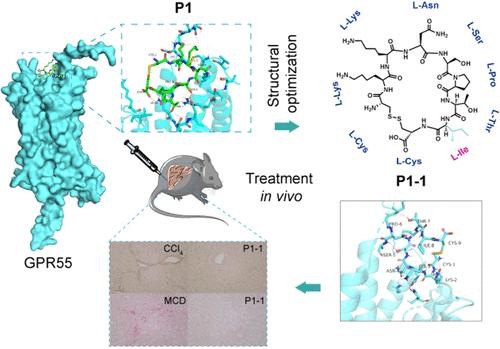当前位置:
X-MOL 学术
›
J. Med. Chem.
›
论文详情
Our official English website, www.x-mol.net, welcomes your
feedback! (Note: you will need to create a separate account there.)
Discovery of Novel Peptide Antagonists Targeting GPR55 for Liver Inflammation and Fibrosis
Journal of Medicinal Chemistry ( IF 6.8 ) Pub Date : 2024-07-11 , DOI: 10.1021/acs.jmedchem.4c00834 Zihan Shi 1 , Xianyan Liu 1 , Shuohan Wu 1 , Nazi Song 1 , Qinglin Tang 1, 2 , Haonan Li 1 , Suijia Luo 2 , Albert S C Chan 1 , Xiaoqing Cai 1 , Han Liu 1 , Xianxing Jiang 1
Journal of Medicinal Chemistry ( IF 6.8 ) Pub Date : 2024-07-11 , DOI: 10.1021/acs.jmedchem.4c00834 Zihan Shi 1 , Xianyan Liu 1 , Shuohan Wu 1 , Nazi Song 1 , Qinglin Tang 1, 2 , Haonan Li 1 , Suijia Luo 2 , Albert S C Chan 1 , Xiaoqing Cai 1 , Han Liu 1 , Xianxing Jiang 1
Affiliation

|
Liver fibrosis is a condition characterized by aberrant proliferation of connective tissue in the liver resulting from diverse etiological factors. G protein-coupled receptor GPR55 has recently been identified as a regulator of liver diseases. Herein, we report the discovery of a cyclic peptide P1-1 that antagonizes GPR55 and suppresses collagen secretion in hepatic stellate cells. The alanine scanning and docking study was carried out to predict the binding mode and allowed for further structural optimization of peptide antagonists for GPR55. The subsequent in vivo study demonstrated that P1-1 ameliorates CCl4-induce and MCD-diet-induce acute liver inflammation and fibrosis. Further study indicates that P1-1 reduces reactive oxygen species (ROS) production, attenuates ER stress, and inhibits mitochondria-associated hepatocyte apoptosis. In this work, we provided the first successful example of antagonizing GPR55 for liver inflammation and fibrosis, which validates GPR55 as a promising target for the treatment of liver fibrosis and affords a high-potent GPR55 antagonist P1-1 as a potential therapeutic candidate.
中文翻译:

发现针对 GPR55 治疗肝脏炎症和纤维化的新型肽拮抗剂
肝纤维化是一种以多种病因引起的肝脏结缔组织异常增殖为特征的疾病。 G蛋白偶联受体GPR55最近被确定为肝脏疾病的调节因子。在此,我们报告发现了一种环肽 P1-1,它可以拮抗 GPR55 并抑制肝星状细胞中的胶原蛋白分泌。进行丙氨酸扫描和对接研究以预测结合模式并允许进一步优化 GPR55 肽拮抗剂的结构。随后的体内研究表明,P1-1 可改善 CCl 4诱导和 MCD 饮食诱导的急性肝脏炎症和纤维化。进一步的研究表明,P1-1 可减少活性氧 (ROS) 的产生,减轻 ER 应激,并抑制线粒体相关的肝细胞凋亡。在这项工作中,我们提供了第一个拮抗GPR55治疗肝脏炎症和纤维化的成功例子,验证了GPR55作为治疗肝纤维化的有前景的靶点,并提供了高效GPR55拮抗剂P1-1作为潜在的治疗候选者。
更新日期:2024-07-11
中文翻译:

发现针对 GPR55 治疗肝脏炎症和纤维化的新型肽拮抗剂
肝纤维化是一种以多种病因引起的肝脏结缔组织异常增殖为特征的疾病。 G蛋白偶联受体GPR55最近被确定为肝脏疾病的调节因子。在此,我们报告发现了一种环肽 P1-1,它可以拮抗 GPR55 并抑制肝星状细胞中的胶原蛋白分泌。进行丙氨酸扫描和对接研究以预测结合模式并允许进一步优化 GPR55 肽拮抗剂的结构。随后的体内研究表明,P1-1 可改善 CCl 4诱导和 MCD 饮食诱导的急性肝脏炎症和纤维化。进一步的研究表明,P1-1 可减少活性氧 (ROS) 的产生,减轻 ER 应激,并抑制线粒体相关的肝细胞凋亡。在这项工作中,我们提供了第一个拮抗GPR55治疗肝脏炎症和纤维化的成功例子,验证了GPR55作为治疗肝纤维化的有前景的靶点,并提供了高效GPR55拮抗剂P1-1作为潜在的治疗候选者。
















































 京公网安备 11010802027423号
京公网安备 11010802027423号